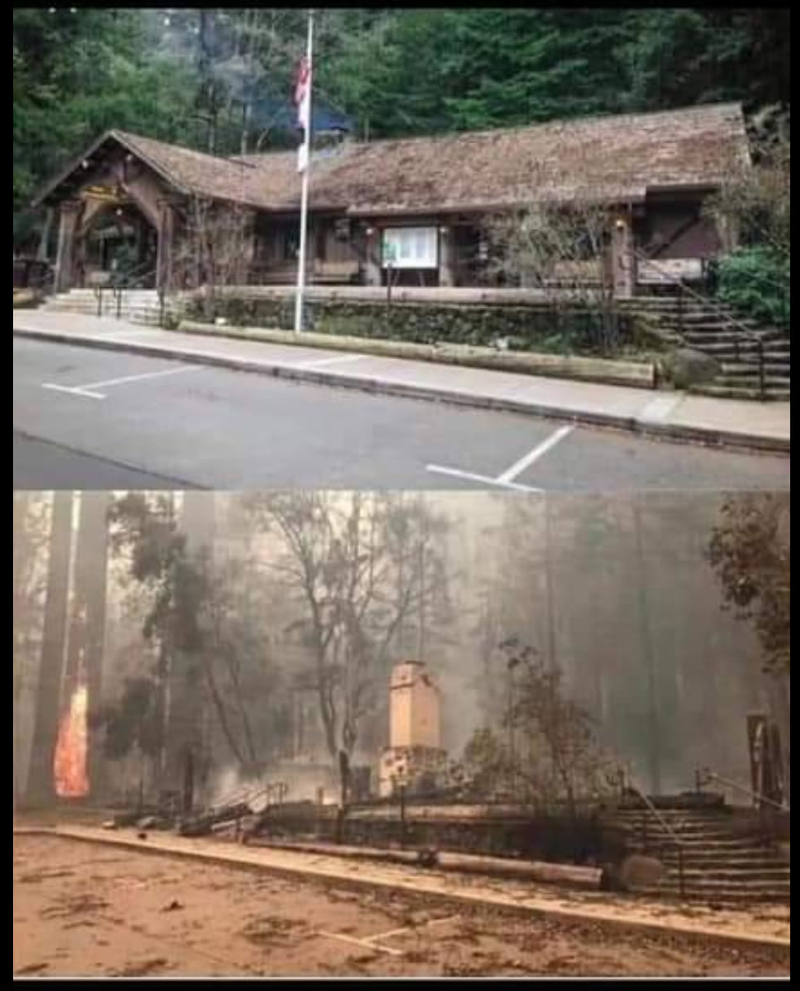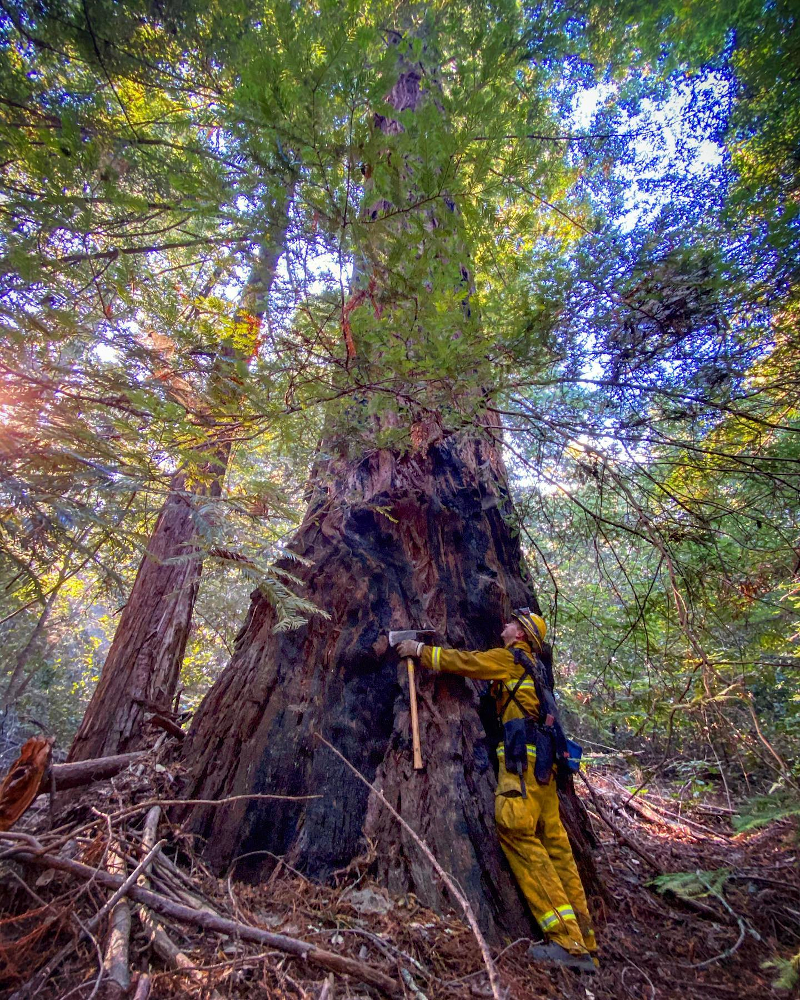
Big Basin Redwoods State Park Headquarters before and after the CZU Complex Fire
Many of you have joined me for a hike through the redwood forest at Big Basin Redwoods State Park. Big Basin is California’s first state park, created in 1902. Its founding gave birth to the California State Parks system, which became the model for state parks in our country today.
I lead these hikes as a naturalist for California State Parks. You find me in park uniform, standing on the stone patio in front of the historic Park Headquarters, built in 1936. The picture above shows park headquarters before and after the fire. In the background of the lower picture, “The Auto Tree” is still burning.
Destruction
The destruction is painful to see. Park headquarters, the old lodge, the gift shop and café are gone. Their character was part of the park’s charm. Bit players on a stage dominated by giants.
A newspaper photographer was able to get into the park shortly after the fire swept through. The pictures and video are heartbreaking for those of us who love the park.
The video in the second link is shot entirely inside the park. Through the smoke and haze I can see familiar places. The forest is eerily silent until you hear the call of an Acorn woodpecker midway through.
Since the pictures and video are licensed, I can only link to them from this article.
These Photos Show How The Oldest State Park In California Has Been Destroyed By Fire
CZU COMPLEX LIGHTNING FIRE: Raw video wildfire ravages Big Basin State Park
The Trees
Redwoods have adaptations to cope with fire. They must. If you stand in one spot for 2,000 years, eventually a natural fire will sweep through. It’s commonplace to see charring on older trees from fires that occurred hundreds of years before you were born.
Redwood trees have flame retardant chemicals incorporated into their thick, protective bark. Occasionally fires penetrate this defense. And over time subsequent fires hollow out the trees to create chambers.
Or, they create a “chimney tree” – alive on the outside but hollow within. I love stepping inside these trees. Standing in darkness, I gaze upward to see blue sky and puffy clouds passing overhead. It’s like standing in a cathedral admiring a stained-glass ceiling. But the effect far surpasses the best efforts of artists and architects.
Many of these giant trees have names. The awesome weight of their presence inspires monikers like “The Mother of the Forest” and “The Father of the Forest.” News reports indicate that many of these large trees survived the fire.
But many of us are worried by what we see. Today, we understand that low-grade fires are a natural part of the ecology. Many plants and animals are adapted to them. And many actually rely on these fires to reproduce.
But decades of fire suppression have led to an unnatural build-up of fuel on the forest floor. Normally, naturally occurring low-grade fires consume the fuel and return nutrients to the forest. But because humans extinguish these natural fires immediately, the fuel accumulates. So when fires like the CZU complex happen, they create an unnatural inferno that stresses the ecology.
We also worry that increased temperatures due to climate change will make it harder for the forest to regenerate. The conditions that redwoods need to grow are endangered by the hotter, dryer climate. We worry that the environment that follows these fires will look more like Los Angeles than the Santa Cruz Mountains.
People

Merced Firefighter with redwood. The City of Merced Fire Department Helped at CZU fire complex (City of Merced FD Facebook Page)
And then there’s the human cost. Some park staff reside within the park and many volunteers live nearby. Some of my friends lost their homes. And others will need to remediate their houses because of the smoke.
The human toll is widespread. Big Basin sees about 250,000 visitors each year. And the campgrounds and trails have been especially vital during the COVID-19 epidemic. Big Basin provided a safe haven to enjoy nature and escape the stresses of daily life.
The Park may remain closed for the next year. The trees have been weakened, and park officials want the forest to survive the seasonal rains before reopening. And rebuilding is needed to provide the facilities that people need to visit the park without destroying it.
The Future
People care about Big Basin. Groups like the Sempervirens Fund and private citizens will help the park system rebuild the structures lost in the fire. It will take time. But I’m hopeful that people will return to Big Basin and that the forest will have thrived in the time people were away.
If you would like to donate to help Big Basin recover, you can do that here.
Articles that feature Big Basin on NatureOutside
What in the World is an Ensatina?
Conquering My Fear at Berry Creek Falls
For fun facts and useful tips, join the free Bushcraft Newsletter.



Steve, I’m at a loss for words. What a tragedy, and what a crossroads for humanity. It’s too soon to plan for the future, but that’s what resilience is, and we must be resilient. I deal more with human tragedy and trauma than natural disasters, but there are parallels. Grief is a process. At the heart of the process is healing – but that can only happen when we are ready to take action and move forward.
We’re in this together. Reach out, we’re here.
Thank you for being you.
Nurse Dux, thank you for your message. I have no doubt that the forest, the park staff, and volunteers will recover from the fire. But I appreciate your important reminder. In the short term, I will try to help my friends who have lost their homes. In the longer term, I will see if I can contribute to restoring the park for visitors.
“No matter how much we try to insulate ourselves from nature, we are a part of her and she will have the final say. Is it not better to live with her than ignore or fight her?”
That’s a great sentiment, Ron. Ancient peoples viewed themselves as a part of nature, not apart from it. Working with nature is likely to be the key to our future on Earth. It will be interesting to see how our attitudes change over the next 50 years.
Forests will be harvested. Man can choose to do it with a chainsaw. If nature is left to choose, it might do it with insects, or landslides, or fire, and nature’s timetable will not be pleasing to us.
Jon, there’s a difference when nature harvests. When nature does it, she returns nutrients to the forest and creates new habitat. When we harvest with chainsaws, we are not doing it in a way that benefits the forest.
The land that is burning is wilderness area set aside by the people of California for nature and recreation. So chainsaws aren’t really an option. They would destroy the old-growth we want to preserve.
We want to preserve. Nature has a different idea and timetable.